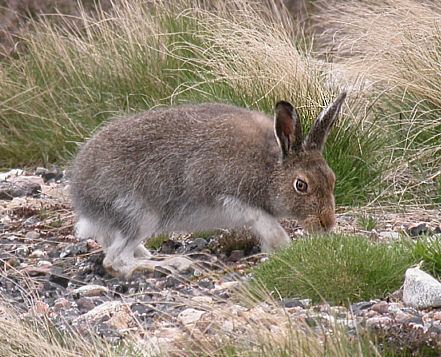 | ||
This is a list of mammals of Great Britain. The Great Britain mammal fauna is somewhat impoverished compared to that of continental Europe due to the short period of time between the last ice age and the flooding of the land bridge between Great Britain and the rest of Europe. Only those land species which crossed before the creation of the English Channel and those introduced by humans exist in Great Britain.
Contents
- Rodents
- Rabbits and hares
- Moles shrews and hedgehogs
- Bats
- Carnivores
- Odd toed ungulates
- Even toed ungulates
- Whales and dolphins
- Wallabies
- Shrews
- References
Great Britain holds, important populations of grey seals, and rare bat species.
Native (usually synonymous with "indigenous") species are considered to be species which are today present in the region in question, and have been continuously present in that region since a certain period of time. When applied to Great Britain, three possible definitions of this time constraint are:
This list includes mammals from the small islands around Great Britain and the Channel Islands. There are no endemic mammal species in Great Britain, although four distinct subspecies of rodents have arisen on small islands.
The following tags are used to highlight each species' conservation status as assessed by the IUCN:
Rodents
Superorder: Euarchontoglires Order: Rodentia
Rodents make up the largest order of mammals, with over 40 percent of mammalian species. They have two incisors in the upper and lower jaw which grow continuously and must be kept short by gnawing. Most rodents are small though the coypu (once introduced to Great Britain, but subsequently eradicated) can weigh up to 9 kg (15.5 lb).
Family: Castoridae (beavers)
Family: Cricetidae (voles)
Family: Muridae (rats, mice and relatives)
Family: Gliridae (dormice)
Family: Sciuridae (squirrels)
Family: Hystricidae (Old World porcupines)
Rabbits and hares
Superorder: Euarchontoglires Order: Lagomorpha
The lagomorphs comprise two families, Leporidae (hares and rabbits), and Ochotonidae (pikas). Though they can resemble rodents, and were classified as a superfamily in that order until the early 20th century, they have since been considered a separate order. They differ from rodents in a number of physical characteristics, such as having four incisors in the upper jaw rather than two.
Family: Leporidae (hares and rabbits)
Moles, shrews and hedgehogs
Superorder: Laurasiatheria Order: Eulipotyphla
The order Eulipotyphla contains insectivorous mammals. The hedgehogs are easily recognised by their spines while gymnures look more like large rats. Shrews and solenodons closely resemble mice while the moles are stout-bodied burrowers.
Family: Talpidae (moles)
Family: Soricidae (shrews)
Family: Erinaceidae (hedgehogs and gymnures)
Bats
Superorder: Laurasiatheria Order: Chiroptera
The bats' most distinguishing feature is that their forelimbs are developed as wings, making them the only mammals in the world naturally capable of flight. Bat species account for about 20% of all mammals.
Carnivores
Superorder: Laurasiatheria Order: Carnivora
There are over 260 species of carnivorans, the majority of which feed primarily on meat. They have a characteristic skull shape and dentition.
Odd-toed ungulates
Superorder: Laurasiatheria Order: Perissodactyla
The odd-toed ungulates are browsing and grazing mammals. They are usually large to very large, and have relatively simple stomachs and a large middle toe.
Even-toed ungulates
Superorder: Laurasiatheria Order: Artiodactyla
The even-toed ungulates are ungulates whose weight is borne about equally by the third and fourth toes, rather than mostly or entirely by the third as in perissodactyls. There are about 220 artiodactyl species, including many that are of great economic importance to humans.
Whales and dolphins
Superorder: Laurasiatheria Order: Artiodactyla Infraorder: Cetacea
The infraorder Cetacea includes whales, dolphins and porpoises. They are the mammals most fully adapted to aquatic life with a spindle-shaped nearly hairless body, protected by a thick layer of blubber, and forelimbs and tail modified to provide propulsion underwater.
Wallabies
Superorder: Australidelphia Order: Diprotodontia
Though most marsupials make up a great part of the fauna in the Australian region, the red-necked wallaby has been introduced and a feral population is currently breeding on the island of Inchconnachan, and at Loch Lomond in Argyll and Bute, Scotland. A smaller group is present on the Isle of Man, and the species is locally extinct in the Peak District, in Cumbria, and at Ashdown Forest in East Sussex.
Family: Macropodidae (kangaroos, wallabies, and kin)
Rodents
Superorder: Euarchontoglires Order: Rodentia
Rodents make up the largest order of mammals, with over 40 percent of mammalian species. They have two incisors in the upper and lower jaw which grow continuously and must be kept short by gnawing. Most rodents are small though the coypu (once introduced to Great Britain, but subsequently eradicated) can weigh up to 9 kg (15.5 lb).
Family: Castoridae (beavers)
Family: Gliridae (dormice)
Family: Sciuridae (squirrels)
Shrews
Superorder: Laurasiatheria Order: Eulipotyphla
Eulipotyphlans are insectivorous mammals. The shrews and solenodons closely resemble mice while the moles are stout-bodied burrowers.
Even-toed ungulates
Superorder: Laurasiatheria Order: Artiodactyla
The even-toed ungulates are ungulates whose weight is borne about equally by the third and fourth toes, rather than mostly or entirely by the third as in perissodactyls. There are about 220 artiodactyl species, including many that are of great economic importance to humans.
